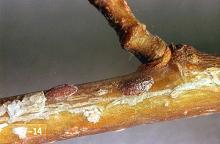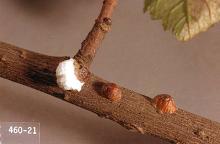Pulvinaria innumerabilis
Pest description and crop damage The cottony maple scale is one of the largest soft scales. Immature forms (crawlers) are flattened and brown to yellowish green in color; however, the conspicuous, cottony egg sac of the mature female is two to three times the length of the scale body, or up to 6 mm. The insects feed on foliage, reducing vigor of the plant and causing twig dieback. Large amounts of honeydew, on which sooty mold will readily grow, is produced and can be a fruit contaminant.
Biology and life history This insect prefer to feed on maples, but will infest a wide array of trees, shrubs, tree fruits and berries. They spend the winter as mated females on twigs and branches. Adults resume feeding in the spring and produce the large cottony egg sac. The eggs hatch in early summer and nymphs feed on the undersides of the leaves near the midrib. At the end of the growing season, winged males appear and mate with the females, which then return to twigs to overwinter.
Scouting and thresholds Inspect plants in spring for cottony egg sacs on twigs and leaves.
Management-chemical control: HOME USE
- There are currently no products labeled for home use.
Management-chemical control: COMMERCIAL USE
- azadirachtin (Neemix 4.5 IGR and other brands)-Consult label for rate. PHI 0 days. Some formulations are OMRI-listed for organic use.
- bifenthrin (Brigade 2EC and other brands) at 0.033 to 0.1 lb ai/A. PHI 1 day. Make cover spray applications when scale crawlers first emerge. Toxic to bees; do not use when bees are foraging. Also toxic to fish and other aquatic invertebrates.
- horticultural oil (several brands)-Consult label for rates. Apply as a dormant spray in early season before buds open. Some formulations are OMRI-listed for organic use.
- insecticidal soap (M-Pede and other brands)-Consult label for rate and use directions. PHI 0 days. Apply when crawlers first emerge. Some formulations are OMRI-listed for organic use.
- malathion (several brands)-Consult label for rates. PHI varies by label. Apply when crawlers appear, as a spray in 100 gal water/A. After June, use 150 to 200 gal water/A. Toxic to bees; do not use when bees are foraging. Also toxic to fish and other aquatic invertebrates.
- pyriproxyfen (Esteem and others) at 0.11 lb ai/A. PHI 7 days. Apply at either dormant, delayed-dormant, or as an in-season cover spray. At dormant or delayed-dormant, use with a horticultural oil. Make cover spray applications when scale crawlers first emerge. Do not exceed 2 applications per growing season.
- spirotetramat (Movento) at 0.13 to 0.16 lb ai/A. PHI 7 days. Do not exceed 0.47 lb ai/A per year. Do not apply until after petal fall.



